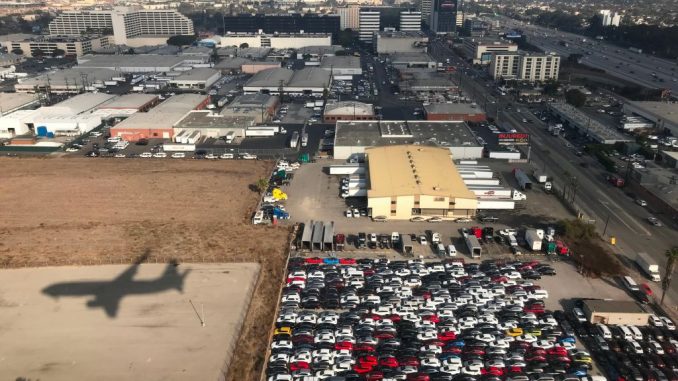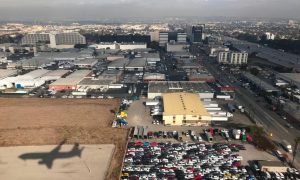

Commentary
About a week ago, on April 21, the Los Angeles mayor released his $11.23 billion budget proposal for the 2021-22 fiscal year.
The night before, Mayor Eric Garcetti gave his State of the City speech, offering some rationale for his budget. He called it “a financial document … but also a roadmap,” providing a vision of the city’s future.
Within that vision, he made the claim that the capital improvement projects at the Los Angeles International Airport (LAX), The Port of Los Angeles and the Los Angeles Department of Water and Power—combined with the proposals he was making for the city-run budget—“are creating more than a million new jobs for our city.”
The Epoch Times has made several requests with the mayor’s office in an attempt to better understand those job creation claims. It has not yet received a response.
It is true that LAX and the Port of Los Angeles are responsible for an enormous amount of economic impact.
Economic impact measures not only the jobs and activity at the port and airport, for example, but also all the jobs made possible because of the port and airport. In addition, it measures all the services that all those people can now afford.
It’s important to put the Garcetti’s ambitious job claim into context.
Breaking it Down
The Department of Water and Power—the largest municipally-owned utility company in the nation—only employees about 10,000 workers. Garcetti’s claim is the equivalent of 100 more Departments of Water and Power utility companies.
According to a Jan. 29 press release, LAX generates a total economic impact of about 742,000 jobs. It’s not surprising given all the activity at the passenger terminals and cargo terminals.
The operator of LAX is Los Angeles World Airport. Its website references a 2014 study that shows LAX generated 620,600 jobs in Southern California based on 2014 operations. “The study also reported that LAX’s ongoing capital improvement program creates an additional 121,640 annual jobs.”
Note that these 742,000 jobs were spread across an entire Southern California, five-county region of Ventura, Los Angeles, Orange, San Bernardino and Riverside. Furthermore, it includes the additional jobs created by the ongoing capital improvement program.
It might be true that the “nearly $15 billion construction program” at LAX mentioned by Garcetti during his State of the City speech will provide slightly different ongoing job gains, but the three major projects currently discussed on the Los Angeles World Airports’ website mention only about 3,450 construction jobs.
The jobs are associated with: building the LAX Automated People Mover (an elevated train), creating 2,200 construction jobs; the LAX Intermodal Transportation Facility, a new parking lot creating 250 construction jobs; and the consolidated rent-a-car facility, which will employ 1,000 construction workers.
The new train and parking lot will likely have an increase in some maintenance workers, but it would likely not equate to a large number of new workers. Presumably, any new workers maintaining the new rental car facility would come at the cost of others no longer maintaining the lots currently used by the rental car companies.
Otherwise, there would be little reason to think that the 122,000 annual jobs to be added through the ongoing LAX capital improvement program should have changed too substantially from the 2014 study.
Again, to put the claim of 1 million new jobs “for our city” into context, it would be the same as eight times all the 2014 economic impact of all the construction activity at LAX.
This seems unlikely.
By far the biggest jobs creator in Southern California is the combined ports at Long Beach and Los Angeles. The Port of Los Angeles web site refers to the combined ports as the “San Pedro Bay port complex.” It says that the total economic impact from the entire San Pedro Bay ports complex is 171,000 jobs. It goes on to say that the economic impact of just the Port of Los Angeles (excluding the Port of Long Beach) is 133,000 (1 in 13) jobs in Los Angeles.
In addition to the “million jobs for our city” claim equating to 100 times the total number of employees at the city’s largest-in-the-nation city-owned utility company, eight times the total economic impact from LAX’s ongoing capital improvement plan or seven times the economic impact the Port of Los Angeles has within the City of Los Angeles, perhaps the most important data regarding the claim is the total size of Los Angeles and the number of workers within the city.
Math Problems
Los Angeles has nearly 4 million people. The labor participation rate for the state of California in March was 60.8 percent, which means Los Angeles has about 2.4 million workers. The March unemployment rate in the Los Angeles-Long Beach-Anaheim region was 9.8 percent. This means there were about 238,000 out-of-work Angelenos in March 2021.
Garcetti’s claim to be creating “a million new jobs for our city” represents more than 4 times the total number of people currently out of work in Los Angeles.
Uncertain Timing
Of course, the claim of 1 million new jobs for the city of Los Angeles may stretch far into the future.
The public is still waiting for the rationale for where and when the million jobs will be created.
And Los Angeles recently agreed with the state to provide 456,643 new homes by 2029.
At an average household size of just under 3 people, and an assumed normalized 64 percent labor participation rate, those 457,000 new households will include up to 875,000 new job seekers, in which case those million new jobs for the city will be welcomed and filled—if the city can actually get that many homes built.
Tim Shaler is a professional investor and economist based in Southern California. He is a regular columnist for The Epoch Times, where he exclusively provides some of his original economic analysis.
Views expressed in this article are the opinions of the author and do not necessarily reflect the views of The Epoch Times.






Be the first to comment